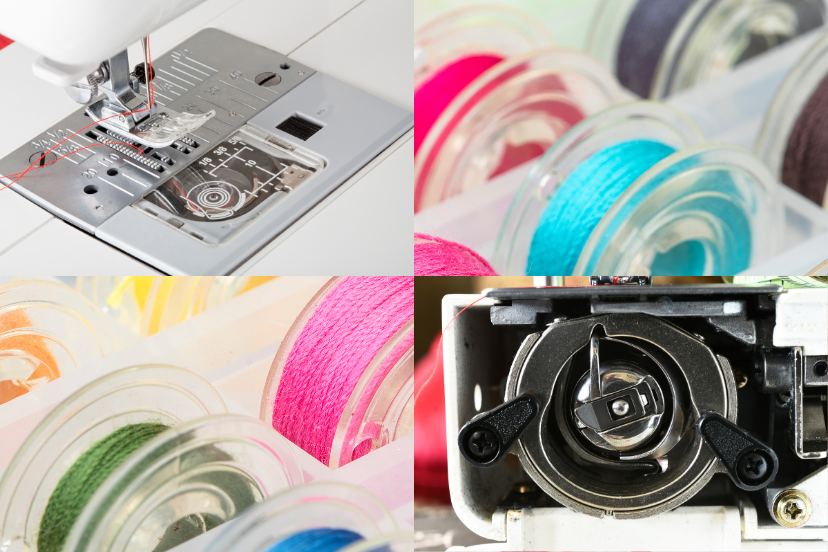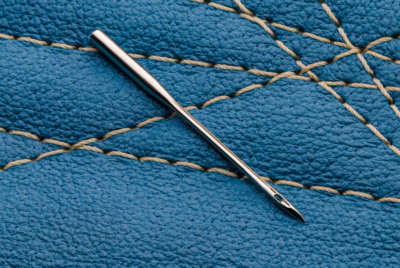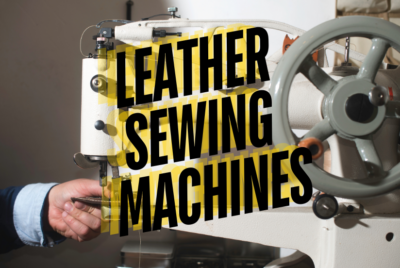Sewing Machine Bobbins Information Guide
If you’re a sewing enthusiast, you know that bobbins are an essential part of your sewing machine. However, with the variety of bobbins available, it can be overwhelming to understand their differences and choose the right one for your projects.
We’ll demystify sewing machine bobbins and explore the various types that are available. Each classification will have a brief description with its advantages and disadvantages.
It’s not enough to know about bobbins, it’s as important to know how to thread and use the bobbin and a bobbin case.
Threading a bobbin is an important step in preparing your sewing machine for stitching. We’ll give you step-by-step instructions. Once threaded, keeping your bobbins organized helps with your sewing projects.
So, let’s unravel the thread and embark on our bobbin adventure!

How Are Sewing Machine Bobbins Used
Sewing machine bobbins are used to hold the lower thread and work in tandem with the upper thread to create balanced and precise stitches.
Regardless of the bobbin type, they serve the same purpose of ensuring a smooth sewing experience.
The choice of bobbin often depends on the sewing machine model, project requirements, and personal preferences.
Understanding the Bobbin Classifications
The bobbin classifications, such as Class 15/A and Class 66, refer to the shape, size, and compatibility with specific sewing machine models. It’s crucial to consult your sewing machine manual or manufacturer’s recommendations to identify the compatible bobbin class for your machine. A wide range of Sewing Machine Bobbins are available at SewingMachinesPlus.
Types of Sewing Machine Bobbins
Class 15/A Bobbins
The Class 15/A bobbins, also known as “A style” or “Class 15J” bobbins, are the most common type used in home sewing machines.
Made of plastic or metal, these bobbins have a flat top and bottom with slightly curved sides. You’ll find the thread neatly wound in a cross pattern.
Advantages
- Widely available and compatible with many sewing machine models.
- Cost-effective and easily found in stores or online.
- Lightweight, making them perfect for everyday sewing projects.
- Suitable for beginners and experienced sewists alike.
Disadvantages
- Smaller thread capacity, requiring more frequent bobbin changes.
- Not as durable as some other bobbin materials, affecting long-term performance.
Class 66 Bobbins
Class 66 bobbins, also known as Singer-style bobbins and sometimes referred to as “L style” bobbins, are commonly used in older Singer sewing machines and industrial sewing machines. They are larger in size compared to Class 15 bobbins, made of metal, and have a slightly dished shape.
Advantages
- Sturdy and durable, making them ideal for heavy-duty sewing.
- Greater thread capacity, reducing the need for frequent bobbin changes.
- Provide better tension control for high-speed sewing.
Disadvantages
- Less widely available than Class 15/A bobbins, especially in physical stores.
- Incompatible with all sewing machine models.
- May be relatively more expensive than plastic bobbins.
Bernina-style Bobbins
Bernina-style bobbins are specifically designed for Bernina sewing machines. These bobbins are made of metal and have a unique cylindrical shape with a flat top and bottom.
Advantages
- Excellent thread tension control, resulting in consistent stitching.
- Sturdy and long-lasting, suitable for heavy fabrics and intricate projects.
- Larger thread capacity, reducing interruptions for bobbin changes.
Disadvantages
- Limited compatibility with non-Bernina sewing machines.
- Relatively higher price point compared to other bobbin types.
- Less commonly available in stores, requiring specific ordering or specialized shops.
Bobbin Threading
Here’s a descriptive, friendly, and informative guide to help you thread a bobbin:
Choose the Correct Thread
Select a thread that matches the type and weight of the thread you’ll be using in the upper thread of your sewing machine. Using the same or similar thread ensures a balanced stitch.
Wind the Bobbin
Place the thread on a spool pin or bobbin winding mechanism on top of your sewing machine. Take the loose end of the thread and pass it through the small hole or thread guide on the bobbin. Some machines may require you to secure the loose end of the thread by wrapping it around a small tension guide on the bobbin winding mechanism.
Engage the Bobbin Winding Mechanism
Push the bobbin winding mechanism to engage it. The exact location and method will vary depending on your sewing machine model. Consult your manual if you’re unsure. Ensure that the bobbin is properly seated on the bobbin winding spindle.
Start Winding
Hold the loose end of the thread with one hand and start the sewing machine. The machine will wind the thread onto the bobbin automatically. Guide the thread evenly as it winds, ensuring it fills the bobbin evenly and doesn’t overlap or bunch.
Tension Control
Some machines have a tension control mechanism for bobbin winding. If your machine has this feature, follow the instructions in your manual to adjust the tension for proper bobbin winding.
Cut and Remove the Bobbin
Once the bobbin is fully wound, cut the thread, and stop the machine. Remove the bobbin from the bobbin winding mechanism, ensuring the loose thread end is free.
Insert the Bobbin into the Bobbin Case
Open the bobbin case and insert the wound bobbin, following the arrows or guidelines on the case to ensure proper placement. Make sure the thread unwinds in the correct direction as indicated in your manual.
Thread the Bobbin Case
Take the loose end of the thread and pass it through the tension spring or guides on the bobbin case. Pull the thread gently to ensure it’s securely in place.
Final Steps
Close the bobbin case and place it back into the machine. Follow your sewing machine manual to properly thread the upper thread. Ensure both the upper thread and bobbin thread are pulled towards the back of the machine, leaving a short tail of both threads.
With the bobbin threaded, you’re ready to start stitching! Remember, if you encounter any difficulties or have specific instructions for your sewing machine model, consult your manual or reach out to the manufacturer’s customer support for assistance.
Why Bobbins Are Important
Sewing machine bobbins may seem small, but they play a big role in achieving professional-looking stitches. By understanding the different types, advantages, and disadvantages, you can confidently choose the right bobbin for your sewing projects.
Class 15/A bobbins are versatile and widely available, while Class 66, Bernina-style, and other specialty bobbins offer specific features for various sewing needs.
Bobbin Questions
Are Sewing Machine Bobbins Interchangeable?
Sewing machine bobbins are not universally interchangeable or compatible across all sewing machines. While some bobbins, like the Class 15/A bobbins, are more commonly used and compatible with a wide range of home sewing machines, it’s important to note that different sewing machine manufacturers may design their machines with specific bobbin types and sizes.
Furthermore, the bobbin case and tension mechanisms of sewing machines are specifically designed to work with a specific bobbin type, ensuring proper thread tension and stitch quality.
Using the wrong bobbin type could result in issues such as inconsistent tension, poor stitch quality, or even damage to your machine.
How To Find The Correct Sewing Machine Bobbin?
While there are universal bobbins available, often referred to as “generic” bobbins, it’s still essential to check their compatibility with your sewing machine.
Universal bobbins can work with a variety of machines, but there can still be variations in size, shape, and thread capacity that can affect their fit and performance.
To ensure optimal sewing results and prevent any potential damage to your sewing machine, it’s always best to use the recommended bobbin type.
Finding the right bobbins for your sewing machine is essential to ensure smooth stitching and optimal performance.
Here’s a friendly and informative guide to help you determine the correct bobbins for your machine.
• Consult Your Sewing Machine Manual
The first and most reliable source of information is your sewing machine manual.It will provide detailed instructions about the specific bobbin type and size recommended for your machine. Look for a section dedicated to bobbins or specifications where the manufacturer provides guidance on the compatible bobbin types.
• Check the Bobbin Class or Number
Many sewing machines use a standardized bobbin classification or numbering system. Look for markings or labels on your machine or in the manual that indicate the bobbin class or number.Common bobbin classes include Class 15, Class 66, or Class L, depending on the machine manufacturer. Knowing the bobbin class will help you choose the right type when purchasing replacements.
• Examine Your Current Bobbins
If you already have bobbins for your sewing machine, inspect them closely. Look for any markings or engravings that indicate the bobbin class or number.Comparing them to the available options in stores or online will help you identify the correct bobbin type.
• Contact the Sewing Machine Manufacturer
If you’re unable to find the information you need, reach out to the sewing machine manufacturer’s customer support. They will be able to provide you with precise details on the compatible bobbin types for your specific machine model. They may also guide you to authorized dealers or retailers where you can purchase the correct bobbins.
• Seek Assistance from Local Sewing Stores or Groups
Visit your local sewing supply stores or connect with sewing groups and communities. The staff or fellow sewing enthusiasts might have experience with your machine model and can provide recommendations on the appropriate bobbins to purchase. They may also be familiar with compatible generic bobbins if your machine allows for their use.
Why Are Correct Bobbins Important?
Remember, using the wrong bobbins can cause tension issues, poor stitch quality, or even damage to your sewing machine.
What is a Bobbin Case?
A bobbin case is a small, metal or plastic housing designed to hold the bobbin securely inside the sewing machine.
It typically consists of a central bobbin slot, a tension mechanism, and various guides and hooks to ensure proper thread placement.
What’s Important to Know
How to Insert
To use the bobbin case, open the bobbin compartment on your sewing machine, usually located beneath the needle plate. The bobbin case is placed into this compartment, often in a specific orientation as indicated by arrows or guidelines. Make sure the case fits snugly into the designated area.
How to Thread
Once the bobbin case is inserted, thread the bobbin through the tension spring or guides on the case. These guides help control the tension of the lower thread. Follow the threading path outlined in your sewing machine manual, ensuring the thread is securely in place.
Bobbin Placement
Insert the wound bobbin into the bobbin case. The thread should unwind in the direction indicated by your machine’s manual. Proper placement ensures that the thread feeds smoothly during sewing.
Tension Adjustment
Depending on your sewing machine, the bobbin case may have an adjustable tension screw or dial. This allows you to fine-tune the tension of the lower thread. Consult your sewing machine manual for instructions on adjusting the bobbin case tension to achieve balanced stitches.
Reassembly and Testing
Close the bobbin compartment and reattach the needle plate. Ensure that the upper thread and bobbin thread are both properly threaded through their respective guides, leaving a short tail of each thread.
Complete a Test Stitch
Before starting your sewing project, perform a test stitch on a scrap fabric to verify that the upper and lower threads are forming balanced stitches. Make adjustments to the bobbin tension or upper thread tension if necessary.
Regular Maintenance
Remember to periodically clean the bobbin case, removing any lint or thread remnants that may accumulate. This helps maintain the smooth operation of the bobbin and prevents thread jams or tension issues.
Conclusion
The bobbin case is an integral part of your sewing machine, responsible for holding the bobbin, and regulating the tension of the lower thread.
By understanding its role and following proper threading and tension adjustment procedures, you can achieve consistent, well-formed stitches in your sewing projects.
RetroSewMachines.com is a participant in the Amazon Services LLC Associates Program. As an Amazon Associate, we earn from qualifying purchases. We also participates in other affiliate programs and may earn a referral commission if you purchase through links on this website. The information presented here is for general educational purposes only.





Comments are closed.